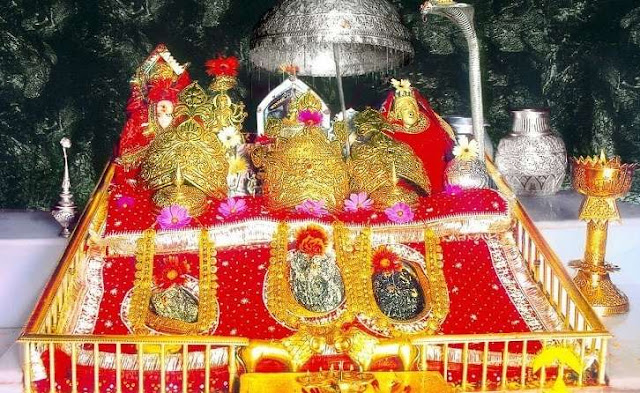The visit to this Shiv Khori cave temple at Ransoo Village in Reasi District of Jammu & Kashmir was a part of AMARNATH JI yatra on 05th July 2014. This was a continuation Yatra to Kailash and Chardham ( Yamunothri, Gangothri, Badrinath and Kedarnath ), with the same Group, but with a change of Travel agency. Our team consists of 20 members. All the arrangements were made by Mr TSR Prabhakaran. The main itinerary in this Amarnath yatra includes Shiv Khori Cave, Shri Vaishno Devi Cave, Mata Kheer Bhawani Temple, Amritsar, Wagah border and Shri Raghunath Temple Jammu.
SHIV
KHORI
The
deities in side the natural cave are Lord Shiva, Ma Parvati, Ganesh, Rishabam, Six hood snake Adiseshan,
Vishnu, Ram Lakshman, Sita and munis.
ARCHITECTURE
This
temple is a natural cave, where rich mineral water trickles from the roof of
the cave forms the Deities, Lord Shiva, Ma Parvati, Ganesha, Rishabam, Six hood
snake, Vishnu, Ram, Lakshman, Sita and munis. The natural cave Shiv Khori is
about 200 meters long separated by small
passage of one meter wide and 1 to 1 ½
meter high. We have crawl through this passage to the other part of the
cave.
Apart
from the entrance to the cave an exit path was created recently in 2014. The
cave extends up to newly formed exist. It was believed that the cave end at Sri
Amarnath Cave.
HISTORY
AND INSCRIPTIONS
The
temple is being maintained by the Shri Shiv Khori Shrine board ( SSKSB ), which
was formed in the year 2003.
Initially
Baba Rameshwar Giri as a Manager was performing pooja with the consent of Local
people. On 31st May 1991, Shri Mata Vaishno Devi Shrine Board of
Katra took over the activities of this
Shiv Khori Cave Shrine, as per the order issued by the Deputy Commissioner of
Udhampur, vide 535/SQ dated 31-05-1991. The
same order was attested by the Tehsildar of Reasi vide 803 dated 29th
July 1991. However, due to legal dispute
between SMVDSB & Rameshwar Giri, SMVDSB could not establish effective
control over the affairs of Shri Shiv Khori Shrine. Latter the infrastructure
facilities like drinking water, electricity, sanitation etc, were created for
the benefit of Devotees by the Shri Shiv Khori Shrine Board ( SSKSB), since
1991 and officially formed from 2003.
LEGENDS
It
is believed that 33 crore deities exists in the cave.
As
per the legend the Bhasmasura did a penance on Lord Shiva and obtained a boon
of burning / killing and makes them as bashpam, when he touches the head of any
body. After getting the boon, the Asura wants to test on Lord Shiva, who has
given the boon. Fearing, Bashmasura’s threat, Lord Shiva came to this cave
along with ma Parvati.
Maha
Vishnu came to his rescue, to the form of Mohini and called Bhasmasura to dance
with him. Followed Maha Vishnu’s steps, at one stage, Bhasmasura touched his own head and became
bashpam / ash. Since then, Lord Shiva, Ma Parvati and Maha Vishnu stayed in
this Shiv Khori Cave Shrine and blesses the devotees.
POOJAS
AND CELEBRATIONS
Apart
from regular poojas, 3 days special
poojas are conducted on Maha Shivaratri
day.
CONTACT
DETAILS
Official
web site : http://www.shivkhori.in/
e-mail
address : shivkhori2008@gmail.com
Suresh
Chandar Asst Manager SSKSB, Ransoo +917889697910, Sh Madan Lam Asst Manager (
P) SSKSB+91 7889484465
HOW
TO REACH
A
beautiful 3.5 Km trek road was formed from the village to the cave shared by
pedestrians, ponies and dolly walas.
Bus
service is available from Katra ( 80 KM ), Udhampur ( 120 KM ) and Jammu ( 140
KM ) on the north side.
LOCATION
OF THE CAVE SHRINE : CLICK HERE
Pony is ready to take you to the cave shrine
View of the valley
A small shrine on the way.
Sri Ram mandir under construction
The neatly paved path to holy cave
Another view of the valley
A bridge - still we have to go further..
Entrance of the holy cave
Entrance to the holy cave
--- OM SHIVAYA NAMA ---































